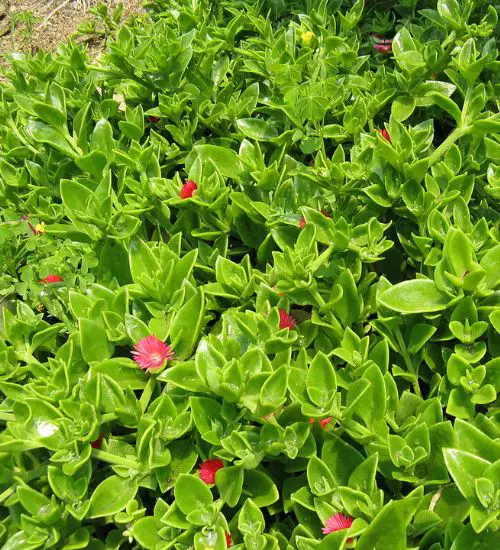Sun: full sun to partial shade
Water: Below average watering needs for a succulent
Temperature: Zone 9a from 20° F to 25° F (-6.7 ° C to -3.9° C) to Zone 10b from 35° F to 40° F (1.7° C to 4.4° C)
Winter Survival: Cold hardy to 0°C
Propagation: cuttings, seeds
Flower: in the Spring or Summer
Flower Type: Red, pink, purple
Toxic: Toxic to humans and animals
Dormant: winter
Space Requirement: Indoors & Outdoors
Common Problems: Plants may rot if overwatered, pests
Where to buy Aptenia cordifolia?
Basc Care for Aptenia cordifolia
Watering
What you need to remember is that this type of succulents needs to be watered for every 2 weeks
Can you water your succulent more than what its need? The answer is yes and no. In extreme conditions, you can water your plants more often when you notice the soil is completely dry.
Fertilizing
Only feed this succulent during its active growing seasons which means winter. Use the right fertilizer applied in the right amounts. Applying half-strength balanced fertilizer every month or so is recommended for optimal results.
Do not fertilize during winter as the plant is dormant.
Sun & Location Requirements for "Aptenia cordifolia"
Aptenia cordifolia does best when placed in an area that receives full sun to partial shade throughout the day. This variety of succulents can tolerate direct sunlight for short periods, but if the temperatures get too high or the light is too intense it may be beneficial to find a shadier spot.
As per this succulent profile, it is only able to stay healthy when the environment temperature is above the range of zone 9a from 20° F to 25° F (-6.7 ° C to -3.9° C).
Aptenia cordifolia is an incredibly resilient species that can survive temperatures as low as 0°F. It has a thick, waxy cuticle that helps protect it from frost damage, and its leaves are able to retain moisture in even the most arid environments. Its deep root system further helps it survive even the coldest winter conditions.
Any succulents in the group will need a medium space to grow. You can place your pot at your table or window. Since this plant needs more space than mini succulents, you should consider do not plant them together with other succulents/plants.
Aptenia cordifolia also benefits from some indirect light throughout the day as well, so make sure you give it enough space to soak up light without becoming too exposed to heat.
Propagation
One way to propagate Aptenia cordifolia is by cutting
Growing Aptenia cordifolia from seeds is an easy and economical way to produce more plants. Identify a healthy seed by its plumpness, dark color and slightly sticky texture. Once the potting mix has been pre-mixed with well-draining soil, sow the seeds evenly and press lightly into the surface. To ensure germination, keep the container in bright but indirect light and mist the soil gently with a spray bottle.
Toxicity

Aptenia cordifolia is a highly toxic plant and should be handled with extreme caution. Ingestion can cause nausea, vomiting and other serious health issues in both humans and animals alike.
Pests and Diseases
Aptenia cordifolia can be affected common pests and diseases like most of the other succulents such as aphids, mealybugs, and scale insects.
If you do spot any of pest signs, you can treat your succulent using below methods.
- Aphids: quarantine, clean infected plants, soapy water.
- Mealybugs: quarantine, clean infected plants, soapy water.
- Scale insects: quarantine, clean infected plants, soapy water.
Besides that, to prevent serious health issues from happening, keep your succulent in a well-ventilated area and check it regularly for any signs of pests or health problems.


